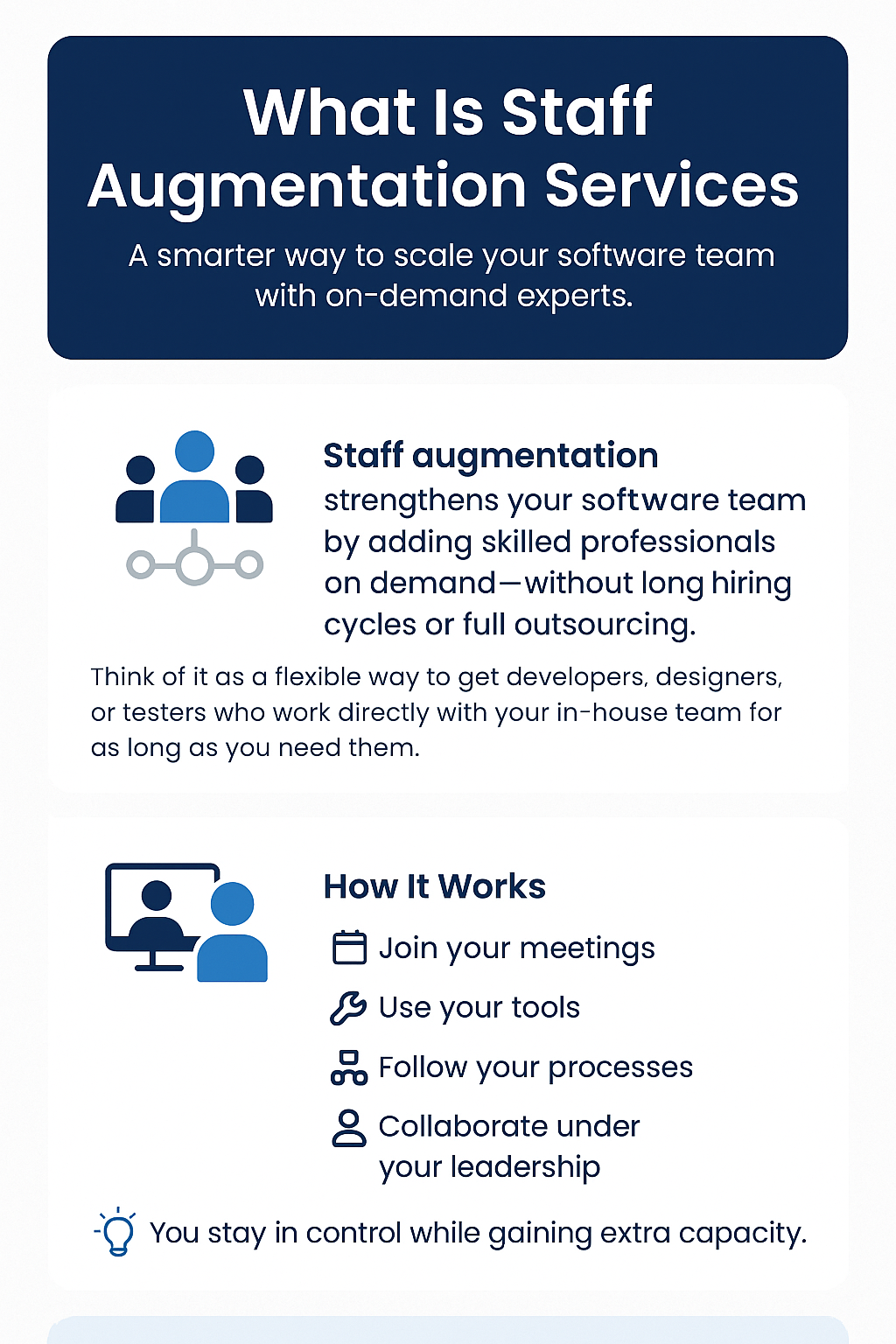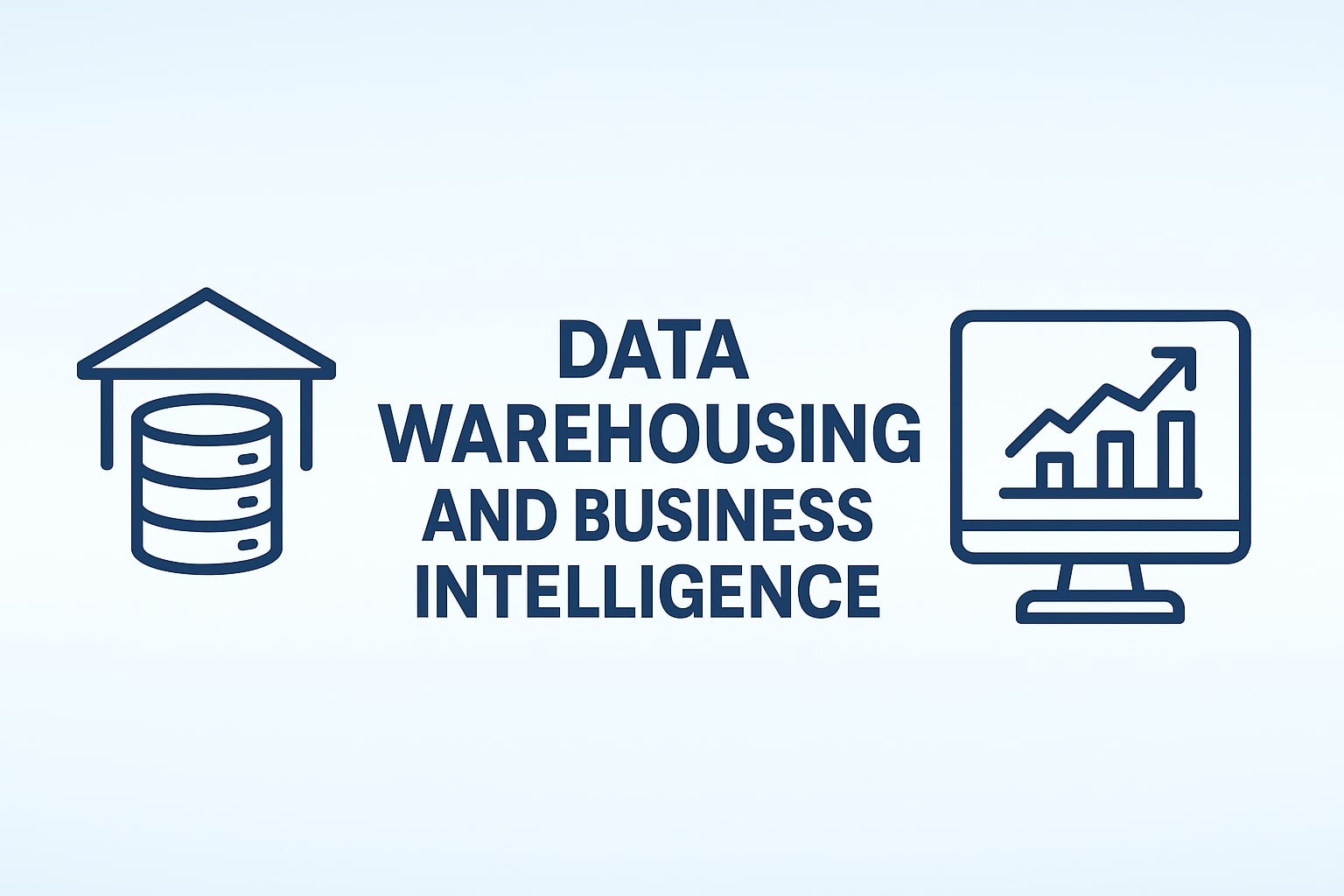If you’ve ever tried to hire good software developers, you know it can feel like searching for water in the desert. One moment your team is in a great rhythm, and the next, a new project pops up, a key developer leaves, or you suddenly need expertise your team doesn’t have.
That’s where software staff augmentation can make a big difference. Instead of taking months to recruit or juggling contractors who don’t quite fit, you can bring in skilled developers who blend right into your existing team. They work alongside your people, follow your process, and help you hit those deadlines that used to feel impossible.
The demand for software talent is only growing. Industry research shows the IT staff augmentation market has been climbing by more than 13 percent annually, and more than half of companies using it report faster delivery times and better project outcomes. In other words, this approach isn’t a quick fix — it’s becoming a smart, long-term strategy for teams that want to stay agile without overloading their budget or their people.
In this guide, we’ll take a closer look at what software staff augmentation really is, how it works, and when it makes sense to use it. We’ll cover the benefits, the challenges, and the process step-by-step, and later, we’ll look at real-world examples of how businesses solve common software development challenges with augmented teams.
By the end, you’ll have a clear picture of how software staff augmentation can help your business grow, stay flexible, and deliver great results — even when projects move faster than your hiring process.
What Is Staff Augmentation Services
When people ask “what is staff augmentation services,” the simplest answer is that it’s a way to strengthen your software team with skilled professionals on demand. Instead of hiring full-time employees or outsourcing an entire project, staff augmentation lets you bring in experienced developers, designers, or testers who work directly with your in-house team for as long as you need them.
These professionals are not freelancers working independently. They become part of your day-to-day operation. They join your meetings, use your tools, follow your processes, and collaborate under your leadership. The difference is flexibility. You can scale your team up or down based on project timelines, workload, or budget without the long hiring cycles or overhead that come with permanent hires.
For example, maybe your business is developing a new software product and your internal team needs extra hands to meet a deadline. Or perhaps you need a developer with a specialized skill set, like cloud architecture or AI integration, that you don’t currently have in-house. Staff augmentation services make it easy to bridge that gap fast while keeping full control of your project.
There are also different ways to structure staff augmentation. Some companies prefer working with on-site developers, while others tap into nearshore or offshore talent to save costs and access broader expertise. No matter where the professionals are located, the idea is the same; they integrate smoothly with your culture and workflow so your business keeps moving forward without skipping a beat.
To put it simply, staff augmentation services help businesses stay agile in a fast-changing tech world. You get the skills and capacity you need, right when you need them, while your team stays focused on what they do best.

When to Use Staff Augmentation Services
Knowing when to use staff augmentation services often comes down to timing and resources. Most companies turn to it when they need extra hands or specialized skills that their current team doesn’t have, but don’t want to commit to full-time hiring.
You might be preparing for a big software launch, tackling a project with tight deadlines, or facing a sudden spike in client work. In each of these situations, staff augmentation gives you the flexibility to bring in the right people quickly without changing the structure of your entire team.
Some of the most common reasons businesses use staff augmentation services include:
-
Short-term project demands: You have a large workload for a few months and need developers who can jump in immediately.
-
Specialized expertise: You need skills in a specific programming language, framework, or technology that your in-house team doesn’t specialize in.
-
Faster delivery timelines: You want to speed up development and meet deadlines without sacrificing quality.
-
Cost control: You’d rather avoid the overhead and long-term costs of hiring and training permanent employees.
-
Team scalability: You want to adjust your team size based on project stages or budget shifts.
Let’s look at two common business scenarios that show how staff augmentation can solve real challenges in software development.
Scenario One: The Product Launch Crunch
A growing SaaS company is preparing to release a major update but realizes its small in-house team can’t complete both the backend enhancements and the new user interface in time. Instead of pushing deadlines or burning out their developers, they bring in three augmented engineers, such as two front-end specialists and one QA tester for four months. They integrate right into the workflow, join daily stand-ups, and deliver the update two weeks early.
Scenario Two: The Skill Gap Problem
A financial technology firm wants to move its product to a cloud-based infrastructure but lacks internal DevOps expertise. Full-time hiring would take months, and the project can’t wait. They decide to use staff augmentation services to bring in a cloud architect and a DevOps engineer for the migration. Within weeks, the project gains momentum, and by the time it’s done, their internal developers have learned new skills from the augmented team.
Both scenarios highlight the same point in that staff augmentation is less about outsourcing and more about building smart, flexible teams that can adapt to whatever your business needs next.
Benefits and Value Drivers of Staff Augmentation Services
The biggest advantage of staff augmentation services is flexibility. You can bring in the talent you need when you need it, without the stress and commitment of full-time hiring. But there’s more to it than just convenience — when done well, augmentation can transform how a business scales, delivers projects, and manages resources.
Here are some of the main benefits that make this model so effective:
Access to Specialized Skills
Software projects often need niche expertise. For example, projects may need a developer who knows React Native, or a data engineer who understands complex integrations. Staff augmentation makes it easy to find those experts quickly instead of spending months recruiting. You can fill gaps instantly and keep your projects on track.
Faster Project Delivery
When your team gets the help it needs right away, deadlines stop feeling impossible. Augmented developers help reduce bottlenecks, boost productivity, and keep projects moving forward without adding unnecessary pressure on your in-house team.
Cost Efficiency
Hiring full-time employees means salaries, benefits, training, and long onboarding times. With staff augmentation, you pay only for the skills and hours you need. That gives you greater control over costs, especially for short-term or seasonal projects.
Greater Control Than Outsourcing
Unlike outsourcing, where an external company manages the entire project, staff augmentation keeps everything under your direction. Your team sets priorities, manages workflows, and maintains control over the code and quality. You get external expertise without giving up oversight.
Smooth Team Integration
The best augmented professionals don’t feel like outsiders. They work side by side with your internal team, adopt your communication style, and use your tools. This helps maintain consistency in culture, workflow, and delivery standards.
Scalability Without the Growing Pains
As your projects evolve, you can scale your team up or down with ease. Whether you’re expanding development for a new product or scaling back after launch, staff augmentation lets you adjust quickly without having to rehire, layoff or undergo a long transition process.
Knowledge Sharing and Upskilling
Working with external experts often leads to valuable skill transfer. Your internal team can learn new technologies, best practices, or workflows just by collaborating closely with augmented developers. It’s one of the most underrated benefits of this model.
Risks, Challenges, and How to Mitigate Them
Like any business strategy, staff augmentation services come with their own challenges. The good news is that most of them can be avoided or managed with the right approach. Knowing what to expect upfront helps you create a smooth experience for both your internal team and your augmented developers.
Here are some of the most common challenges and how to handle them effectively:
Cultural and Communication Differences
When you bring in developers from different regions or backgrounds, it’s natural for communication styles to vary. Time zones, language nuances, and work habits can all affect collaboration.
How to fix it: Establish clear communication channels from the start. Use tools like Slack, Teams, or Jira to keep everyone connected and aligned. Daily stand-ups or short sync meetings help prevent misunderstandings and maintain team cohesion, even across time zones.
Onboarding and Integration
Even highly skilled developers need time to learn your processes, tools, and expectations. Without a proper onboarding plan, productivity can dip in the first few weeks.
How to fix it: Treat onboarding for augmented staff the same way you would for full-time hires. Give them access to documentation, introduce them to team members, and clarify roles early. A little structure upfront makes a big difference later.
Data Security and Intellectual Property
When outside developers access your systems or source code, protecting sensitive information becomes a top priority.
How to fix it: Always work with reputable augmentation partners who have clear security protocols and sign NDAs. Set permissions carefully and ensure contracts outline ownership of all deliverables.
Quality Control
Different developers may have slightly different coding standards or testing methods. If not aligned, this can lead to inconsistencies in the final product.
How to fix it: Define coding guidelines and quality benchmarks early. Have regular code reviews and encourage open feedback within the team. Shared accountability helps keep standards high.
Overreliance on External Talent
If a business becomes too dependent on augmented staff, it can create challenges when contracts end or projects shift.
How to fix it: Pair augmented developers with internal team members whenever possible. This encourages knowledge transfer and helps your core team stay confident and capable.
How Staff Augmentation Services Work
Now that you know what staff augmentation services are and why they’re valuable, let’s look at how the process actually works. While the exact steps can vary depending on your provider or project, the overall flow is usually straightforward and practical.
1. Assessing Your Needs
It all starts with identifying what your team is missing. Maybe you need a backend developer for a few months, a designer for a product refresh, or a QA engineer to tighten up testing. This stage is about defining the skills, experience level, and time frame you’re looking for.
Think of it as a short but focused audit identifying what’s slowing your team down, and what kind of help would move things forward.
2. Choosing a Partner or Provider
Once you know your needs, the next step is finding the right augmentation partner. A good provider does more than just send resumes; they understand your project, your goals, and your company culture. They’ll pre-vet candidates, confirm technical expertise, and make sure each person they recommend can truly integrate with your existing team.
3. Interviewing and Selection
You’ll typically get a shortlist of candidates who match your requirements. This is where you can interview, review their experience, and make sure they fit your workflow. Many companies treat this stage like hiring an internal employee and that’s a good thing. The more alignment you create early, the smoother things will go later.
4. Onboarding and Integration
After you select your augmented developers, it’s time to bring them into your ecosystem. That means setting up access to tools, introducing them to team members, and outlining your project’s goals and communication style. Even though they may be temporary, treat them as part of your team from day one. It builds trust, accountability, and motivation.
5. Active Collaboration and Project Work
This is where the real work happens. Your internal and augmented developers collaborate daily, share progress in meetings, and contribute to the same codebase. The goal is seamless integration with no silos, no barriers, just one unified team working toward a shared outcome.
6. Monitoring and Performance Management
Regular check-ins and feedback help keep everyone aligned. Whether it’s sprint reviews, progress reports, or one-on-one syncs, staying connected ensures that performance stays high and expectations remain clear.
7. Scaling Up, Down, or Transitioning
When the project wraps up or shifts direction, you can easily adjust your team. You might keep a few augmented developers for ongoing maintenance or scale down once delivery is complete. Many companies also choose to hire standout augmented staff full-time, which is a win-win for both sides.
Comparing Staff Augmentation to Other Hiring Models
When companies start exploring how to expand their software teams, they often weigh a few main options: outsourcing, managed services, traditional hiring, and staff augmentation. Each model has its advantages, but they differ in how much control you keep, how flexible they are, and how quickly you can see results.
The table below highlights how these approaches stack up in key areas:
| Model | Ownership & Control | Flexibility | Speed to Start | Best For | Main Drawback |
|---|---|---|---|---|---|
| Staff Augmentation | You manage the work directly with added talent integrated into your team | Very high — scale up or down easily | Fast — usually within days or weeks | Filling skill gaps, scaling existing teams, accelerating delivery | Requires internal management and coordination |
| Outsourcing | The provider manages the entire project | Moderate — scope changes can be harder | Moderate — setup takes time | Projects that can be handled externally with minimal input | Less control and possible misalignment with internal goals |
| Managed Services | The provider owns and maintains a specific function | Low — contracts are often long-term | Moderate | Ongoing IT or operational support | Limited flexibility and less direct oversight |
| Traditional Hiring | Full ownership within your company | Low — difficult to scale quickly | Slow — hiring can take months | Building a long-term, stable team | Higher costs and long recruitment cycles |
Staff augmentation services often sit right in the sweet spot because it gives you the flexibility to respond quickly to new demands while keeping control of your processes, priorities, and people. It’s ideal for teams that want to grow strategically rather than reactively.
Choosing the Right Staff Augmentation Provider
Finding the right partner for staff augmentation services can make all the difference between a smooth, productive experience and one that feels like extra work. The best providers act like an extension of your business — they understand your goals, respect your process, and bring in people who fit both technically and culturally.
Here are a few key things to look for when choosing your partner:
Proven Experience in Your Industry
Every industry has its own quirks and priorities. A provider with experience in software development — or better yet, your specific niche — will already understand the pace, tools, and challenges your team faces. Look for case studies or examples that show successful placements in similar projects.
Transparent Vetting and Selection
A strong provider doesn’t just hand over resumes. They pre-vet each candidate, check technical skills, and make sure the developer is ready to integrate with your workflows. You should have the freedom to interview and approve anyone before they join your team.
Clear Communication and Support
Communication is everything. Choose a provider that offers a single point of contact, clear updates, and fast response times. Good communication keeps things running smoothly and builds trust quickly — especially if you’re working across time zones.
Flexible Engagement Terms
One of the main advantages of staff augmentation is scalability, so flexibility should be built into your agreement. Whether you need one developer for a few months or a whole team for a year, your provider should be able to adjust with you as projects evolve.
Strong Security and Compliance Standards
If your project involves sensitive data, make sure the provider follows strict security policies and signs NDAs. Ask how they manage access, data protection, and intellectual property. These details matter, especially in regulated industries.
Positive Client Feedback
Don’t skip the reviews. Client testimonials or verified references can give you a good sense of how the provider operates in real scenarios — not just how they describe themselves on paper.
Measuring Success and Key Performance Indicators
Once you’ve built your augmented team, the next step is knowing whether it’s truly working for your business. Success with staff augmentation services isn’t just about finishing a project — it’s about improving productivity, collaboration, and overall efficiency.
Tracking the right performance indicators helps you see what’s working, identify bottlenecks, and make informed decisions about scaling or adjusting your team.
Here are a few key metrics worth monitoring:
Time to Productivity
This measures how quickly new team members ramp up and begin contributing to your project. A short ramp-up period shows that your onboarding process is effective and that the augmented staff integrated smoothly with your internal team.
Delivery Speed and Milestone Completion
If deadlines are being met consistently or even earlier than planned, it’s a good sign your augmented team is functioning well. Regularly track milestones and sprint completions to measure overall delivery speed.
Quality of Work
Review code quality, testing results, or client feedback to ensure the work being done meets your standards. Regular code reviews and QA reports help maintain high quality across both internal and external developers.
Collaboration and Communication
Strong collaboration is one of the best indicators of success. Pay attention to how well your augmented developers interact with your internal team, contribute ideas, and adapt to your workflows. Tools like Slack or Jira can give you insights into communication frequency and response times.
Cost Efficiency
Compare the costs of augmentation against traditional hiring or outsourcing. Many businesses find that they save significantly once they account for reduced recruitment time, overhead, and benefits costs.
Retention and Continuity
If you find yourself re-engaging the same provider or even the same developers for future projects, that’s a clear sign the partnership is working. Consistency over time is one of the strongest indicators of trust and success.
Best Practices for Success
Bringing in new talent through staff augmentation services can transform how your team operates, but success depends on more than just hiring the right people. It’s about how you manage, communicate, and set expectations from day one.
Here are a few best practices that help make staff augmentation run smoothly and deliver real results:
Treat Augmented Developers Like Part of Your Team
Even though they may be temporary, treat your augmented professionals as equals. Include them in meetings, acknowledge their wins, and make sure they feel valued. When people feel like part of the team, they’re more motivated to produce their best work.
Set Clear Goals and Expectations
From the start, outline what success looks like. Define project timelines, responsibilities, and performance standards so everyone is on the same page. Clarity removes confusion and helps your team stay focused on shared objectives.
Communicate Early and Often
Frequent communication keeps projects on track and prevents small issues from growing into big problems. Daily stand-ups, progress updates, and open feedback channels make it easy for everyone to stay aligned, especially when teams are remote or distributed.
Use Tools That Support Collaboration
Project management and communication tools like Jira, Asana, or Slack help everyone work from the same playbook. Use shared dashboards and documentation so internal and augmented teams can easily access what they need.
Encourage Knowledge Sharing
When external developers bring in new skills or insights, encourage your internal team to learn from them. Pair programming, peer reviews, and shared training sessions help everyone grow. It turns temporary support into long-term value.
Keep an Eye on Team Morale
When you add new people, team dynamics naturally shift. Pay attention to how your internal team feels about the changes. Check in regularly to make sure everyone feels supported and appreciated.
Plan for Transition and Handoffs
When a project ends or an augmented developer rolls off, have a clear offboarding plan. Document key learnings, code updates, and unfinished tasks. Smooth transitions protect project continuity and prevent knowledge loss.
At its best, staff augmentation isn’t just about filling gaps, it’s about creating a stronger, more balanced team. When you combine clear communication, mutual respect, and good structure, the results go beyond hitting deadlines. You build a team that grows, adapts, and succeeds together.
Common Myths and Misconceptions
Like many business models, staff augmentation services have picked up a few misconceptions over the years. Some come from bad experiences, others from confusion with outsourcing or freelancing. Let’s clear the air and look at what’s actually true.
Myth 1: “Augmented staff aren’t as committed as full-time employees.”
This one comes up often, but the reality is that commitment has more to do with management and communication than employment type. When augmented developers are welcomed into the team, given clear goals, and treated with respect, they’re just as invested in the project’s success as anyone else.
Myth 2: “It’s too expensive.”
Staff augmentation can actually be more cost-effective than hiring full-time. You pay only for the skills you need, for as long as you need them. There are no recruitment fees, benefits, or long-term overhead costs. When managed well, the flexibility can significantly reduce overall project expenses.
Myth 3: “It’s the same as outsourcing.”
It’s easy to confuse the two, but they’re not the same. Outsourcing means handing a project to another company to manage and deliver on its own. Staff augmentation keeps control in your hands. You lead the project while external talent supports your goals from within your process.
Myth 4: “It takes too long to get people up to speed.”
A good provider will make onboarding quick and painless. Most experienced developers are used to joining new teams and adapting fast. With a clear introduction to your systems, tools, and communication style, they can often start contributing in just a few days.
Myth 5: “It’s only for big companies.”
Staff augmentation is used by startups, mid-sized businesses, and enterprises alike. For smaller teams, it can actually be a game-changer giving them access to specialized talent that would otherwise be out of reach.
Why Partner with Atiba for Staff Augmentation Services
Building software today requires more than just talent. It takes flexibility, speed, and the right people working together at the right time. That’s exactly what staff augmentation services were designed for. Whether you’re tackling a new project, scaling a team, or filling a skill gap, this model helps you grow smarter without the stress of full-time hiring.
At Atiba, we’ve spent decades helping businesses do just that. Our hybrid team of developers, designers, and engineers blends technical skill with real-world experience to fit seamlessly into your existing workflows. We don’t just fill seats. We strengthen teams.
When you partner with Atiba, you get:
-
Access to top-tier software talent across multiple tech stacks
-
Developers who integrate smoothly with your tools, culture, and project goals
-
Transparent communication and support from start to finish
-
Flexible contracts that scale with your needs
-
A U.S.-based company with deep global reach and proven project success
If you’re ready to see how staff augmentation can help your business deliver faster, build stronger, and stay ahead of the curve, we’d love to talk.
Get in touch with Atiba to learn how our software staff augmentation services can help your team reach its next big milestone.








